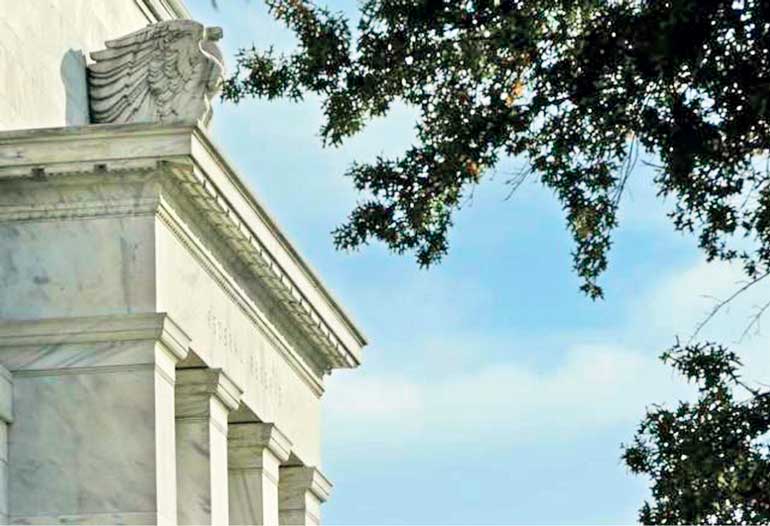Wednesday Feb 12, 2025
Wednesday Feb 12, 2025
Wednesday, 27 July 2016 00:00 - - {{hitsCtrl.values.hits}}

The United States Federal Reserve Board building is shown in Washington 28 October 2014
San Francisco (Reuters): The U.S. Federal Reserve is expected to keep interest rates unchanged this week, deferring any possible increase until September or December, as policymakers hold out for more evidence of a pickup in inflation.
Central to the debate at the Fed’s July 26-27 policy meeting will be how to reconcile upbeat U.S. economic data, highlighted by strong job gains in June, with a global growth slowdown and other headwinds threatening the inflation trajectory.
For San Francisco Fed President John Williams, one of the 17 members participating in the central bank’s rate-setting deliberations, all that is needed is a bit more confidence that inflation is indeed headed toward the Fed’s 2% target.
The inflation measure the Fed prefers to track is currently at 1.6%.
With monthly job gains well above the level needed to prevent an uptick in unemployment, and no signs of a rise in productivity, some Fed policymakers are likely to argue for a quick increase in rates to avoid a surge in inflation.
“That is the danger – and you can be sure that the hawks are going to be arguing that,” said Alan Blinder, a Princeton University professor and a former Fed vice chairman. “I have a hunch that they will talking in July about September.”
Other policymakers, like influential New York Fed President William Dudley, have signaled they would rather wait for more tangible signs of a rise in inflation before pulling the trigger on a rate increase.
“There’s not a lot of reason to raise rates until inflation goes up,” said Kevin Logan, chief U.S. economist at HSBC in New York.
The U.S. central bank is scheduled to issue its latest policy statement at 2 p.m. EDT (1800 GMT) on Wednesday.
Headwinds
The Fed raised its benchmark overnight interest rate in December for the first time in nearly a decade, and signaled four rate hikes were coming in 2016 as it moved to “normalise” the ultra-stimulative monetary policy adopted in response to the 2007-2009 financial crisis.
But headwinds in the global economy, financial market volatility and uncertainty over the impact of Britain’s decision to leave the European Union forced it to delay a rate hike and scale back the number of projected hikes to two for the year.
Still, absent a shock to markets or a reversal in U.S. economic data, even dovish policymakers like Dudley have signaled that their cautious approach to normalising monetary policy likely allows for at least one rate hike this year.
After Wednesday, the Fed has three more policy meetings scheduled this year - in September, November and December. A November rate hike is seen as highly unlikely, as that meeting comes one week before the U.S. presidential election.
Economists polled by Reuters expect the Fed to hold rates steady until after the election.
“Rate normalisation has fallen down the Fed priority list and will remain there until the dust is well settled on the financial markets and the economy,” Jefferies economists predicted in a note last week.
Discover Kapruka, the leading online shopping platform in Sri Lanka, where you can conveniently send Gifts and Flowers to your loved ones for any event including Valentine ’s Day. Explore a wide range of popular Shopping Categories on Kapruka, including Toys, Groceries, Electronics, Birthday Cakes, Fruits, Chocolates, Flower Bouquets, Clothing, Watches, Lingerie, Gift Sets and Jewellery. Also if you’re interested in selling with Kapruka, Partner Central by Kapruka is the best solution to start with. Moreover, through Kapruka Global Shop, you can also enjoy the convenience of purchasing products from renowned platforms like Amazon and eBay and have them delivered to Sri Lanka.
Discover Kapruka, the leading online shopping platform in Sri Lanka, where you can conveniently send Gifts and Flowers to your loved ones for any event including Valentine ’s Day. Explore a wide range of popular Shopping Categories on Kapruka, including Toys, Groceries, Electronics, Birthday Cakes, Fruits, Chocolates, Flower Bouquets, Clothing, Watches, Lingerie, Gift Sets and Jewellery. Also if you’re interested in selling with Kapruka, Partner Central by Kapruka is the best solution to start with. Moreover, through Kapruka Global Shop, you can also enjoy the convenience of purchasing products from renowned platforms like Amazon and eBay and have them delivered to Sri Lanka.